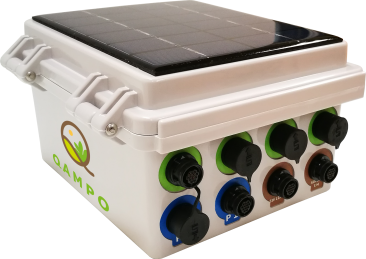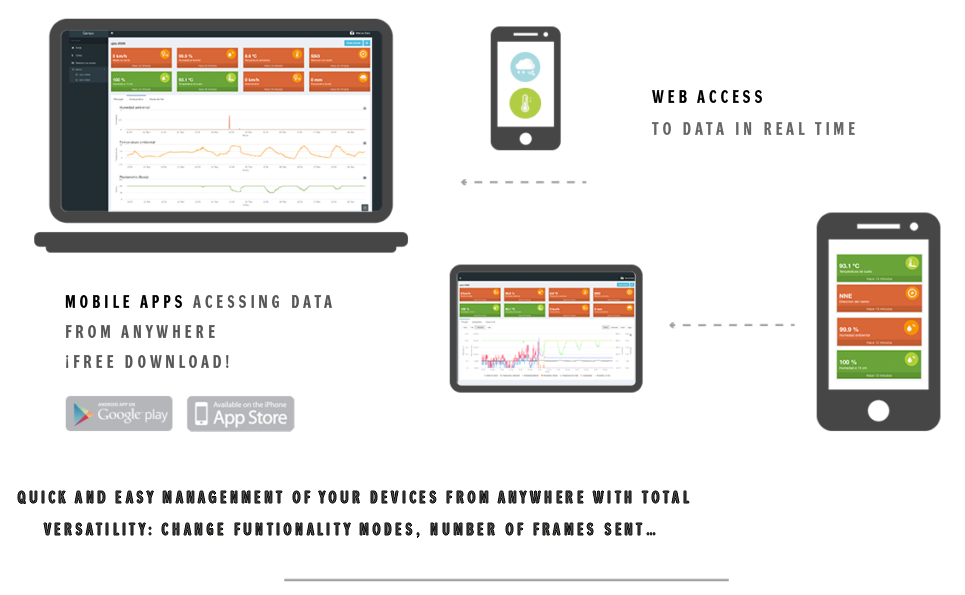
Qbic series range of all-weather battery powered data-loggers are charged by integrated solar panels

This family of data loggers offer a great degree of versatility and allows for the connection of a wide variety of sensors with differing signal outputs, including digital, analogue and SDI12. Installation in the field is quick and simple, especially using the models with pre-wired push/pull connectors. Data Visualisation and download is available from any internet connected browser, or via smartphone connection using the free to download apps
Vineyard Application: The Concejo Cellar is located in village of Valoria de la Buena in Valladolid
Introduction:The grapevine’s scientific name is Vitis vinifera, usually having a very long life span as much several centuries. It has a large root system that takes many years to fully develop, therefore it is a crop that can not easily be renewed, so the need to keep it healthy during the winter months or in extreme dry weather makes these woody plants quite demanding.

The vine is especially sensitive in its early years and care must be taken to control all external elements for proper growth and development.The vine is characterised by large oxygen harvesting leaves which combine with water and nutrients absorbed from the ground, molecules of acids, sugars, etc to provide the conditions for grape production whilst conditioning their particular flavour.
Edaphoclimatic Requirements
Temperature In winter, the lowest temperatures that can be tolerated are down to -20 °C. There would be serious damage at this temperature including the death of buds in the shoots of that year, which is more likely to happen in young and vigorous vines. Heavy frost damage below -2 °C after sprouting causes severe damage to the crop limiting bud development and reducing yield. Due to the high value of established vines, artificial fogging and expensive temperature controlled irrigation are used fight again the frost damage. Temperatures that are too high (30-34 °C), especially if accompanied by dry, moisture-wicking wind, are temperatures that scorch leaves and destroy fruit clusters
Precipitation
The water management of any crop depends on many factors such as temperature, rainfall, humidity etc.The grapevine has a powerful root system that runs deeply in the soil and requires relatively little water. Rainfall of between 350 and 600 millimetres per year is adequate for good wine production quality, so the contribution of water through irrigation should be used sparingly as a measure of “stress reduction.” Water stress causes a reduction in growth of the vine, both in vegetative terms (root, trunk, branch and leaves) and reproductive capabilities (berries and clusters), which translates into a decrease in crop harvest.
The grapevine is not a traditional crop because in some situations a water deficit is actually necessary, for example during the late stages of the berry life cycle, limiting the water intake will increase the appearance of sugars in the grape therefore ensuring higher quality during the final ripening process.
This particular Vineyard has a drip irrigation system, which offers the benefits of minimising the expense and amount of water and energy used, reducing the occurrence of disease by incorporating controlled amounts of pesticides and fungicides and saving manpower.
Ground Conditions
The grapevine is adaptable to a lot of types of soil. In general, grapevines grow best in well-drained, slightly acidic soil that is neither deficient in nutrients nor overly rich.
» Level of pH :: Grapevines do best when grown in soil with a pH level of 5.0 to 6.0. …
» Macronutrients :: Grapevines need nitrogen and potassium in order to thrive. …
» Trace Minerals are essential. …
» Texture :: Grapevines need plenty of loose, well-drained soil below ground for root development.
The pH of the soil is of fundamental importance for the choice of the root-stock, if this is not adequate then it causes Chlorosis in the plant and the continuous use of correctors will be required to combat this.

In Spain, this kind of cultivation counts for more than 1 million hectares, which makes it the country with the largest cultivated area of vines in the world.Area ClimatologyValoría la Buena is a village in the central area of Castilla y León in the district of Valladolid. The historical weather data is:

In the image above we can see that the rainfall is 443 mm as mentioned previously, precipitation must be between 350 and 600 mm which allows us to to confirm that except for especially dry years, this will meet the requirements of the crop with respect to total volume. If we look at its distribution however, we can observe that the rainfall is greater in the Spring months (April, May and June) and Autumn (October, November and December).
The highest water needs for the crop are during the Spring and early Summer period. This last period should be supported with irrigation because the needs are still high and the rainfall very limited or nonexistent.Regarding the local soil we can interpret the below data provided by Itacyl.
We can see that the soil characteristics are, clay loam with a good amount of organic matter around 2%, regarding pH these are basic soils that will produce wines with lower acidity.

Qampo Qbic Data-logger Solution
After an initial study of the vineyard layout, soil type, irrigation system and the climatology of the area, it was decided to install a Qampo Suelo+ station, which has the following characteristics:
» Continuous monitoring of temperature and ambient humidity:
» Pluviometry
» Irrigation monitoring: irrigation cycle time and metered water volume
» Monitoring of soil moisture and temperature at 3 depths using Sentek Drill and drop sensors
» Frost Detection Sensors
» Leaf wetting sensors
» Solar radiation
» GPRS wireless communications
» Datalogger Qbic 8C-GPRS (Pulse Input, 4-20mA input, SD12 Input etc)
» Secure access to the Qampo “cloud based” display platform
Installation:
The installation of the Qampo Suelo+ station is made easy thanks to its installation kit. The Qbic 8C-GPRS datalogger features an integrated solar panel, so no power cables are required for installation. It has external quick-connect IP67 connectors. The rain gauge and temperature sensor are attached on the pole where the Qbic is also fixed. All of this is done by means of supports and anchors that are part of this installation kit.
For the irrigation monitoring, volumetric water meters 15 mm (DN15- DN100 available) are installed, making use of some adaptors for different pipe types.The sensor chosen for the measurement of soil humidity and temperature is the Australian manufacturer Sentek, specifically using a tube sensor of the Drill and Drop family length 30 cm. Which has 3 sensors for the measurement of soil temperature and water content of the soil, each separated by 10 cm depth. One of the great advantages of this type of sensors is its simple installation, which uses a battery powered drill, a soil bit 30 cm in length, and a level tool to make the drill perpendicular during use. Once the hole is made, you simply insert the tube sensor and connect it to the Qbic datalogger.
The complete installation of the station takes about 45 minutes. Once completed, you turn on the Qbic datalogger with its switch which then automatically starts to transmit data to the cloud based platform for instant viewing and analysis or later historical comparison and download….. with the option of programmable SMS / email alarm conditions.

Operation:
Once the Qbic station is installed and connected to the Qampo web platform the data collected from the vineyard vine rows and surroundings, including irrigation system data, soil conditions
and other gathered environmental, data we can begin to form an accurate overview of local growing conditions and obtain an initial recommendation of irrigation based on the calculation of ETo (Evapotranspiration), also based on the climatological data of the area and the state of development of the crop. This first recommendation of irrigation is compared with the farmer’s irrigation data to improve decision making.Once the irrigation routine is applied through the Qampo platform, it is possible to monitor the data of the soil moisture sensors in real-time, and thus adjust the irrigation cycle dynamics to the exact needs of the crop.
As we have already mentioned, each station incorporates a rain gauge through which we can exactly monitor the amount of rainfall that has occurred over time, in order to synchronise the need for additional irrigation to the local weather. The sensors for measuring temperature and humidity enable us to know the crops exposure to temperature fluctuations, which enables us to make decisions in advance, and also to maintain a record of the the localised climate condition during the development of the crop for future comparison.

In addition to the sensors discussed above, there have been two more types incorporated into the system following initial installation
- Frost detector: this sensor imitates a leaf and monitors the temperature drop in real-time, so it sends an alert by sms or email if the probability of frost is high. There is also the possibility that the device automatically switches an electro-valve or relay to activate any anti-freeze system used in the Vineyard
- Leaf wetting: To spray or not to spray? Now you know.
Benefits of Qampo:
The Qampo Qbic Suelo+ 8C station offers important advantages and opportunities to the farmer:
- Knowing when and how much to irrigate, taking into account the local conditions, and the time of the development of the crop. All of this will be extremely helpful to the farmer.
- Having a record of both irrigation and rainfall throughout the campaign. To know exactly how many cubic meters per hectare have been watered in the monitored period and how this has been distributed over the months, weeks or days. To know how much it has rained every month, every week or every day. All of this will be available at any time to the farmer.
- Knowing the exact weather conditions of the plot and to be able to analyse them in a historical way. To extract data, such as the hours of cold and heat to be able to make decisions in advance or improvements in the next growing / planting phase.
- Having all the information accessible in a practical and simple way on your PC, Tablet or Smartphone
- the possibility to set alerts from data of all measured parameters
- Preventing frost damage risks in real-time
- Predicting the appearance of different diseases in the vineyard
- Having historical data to improve future decision making

